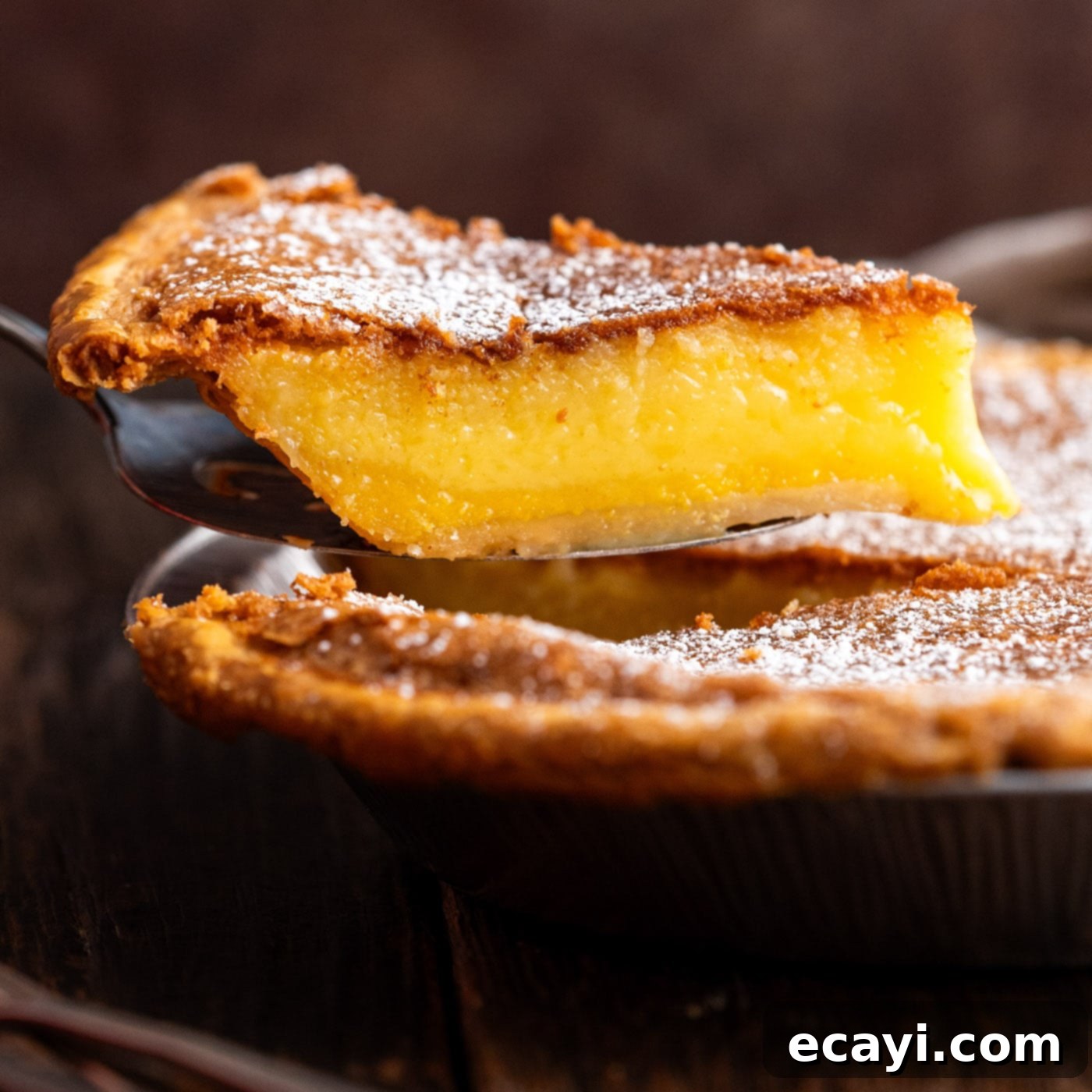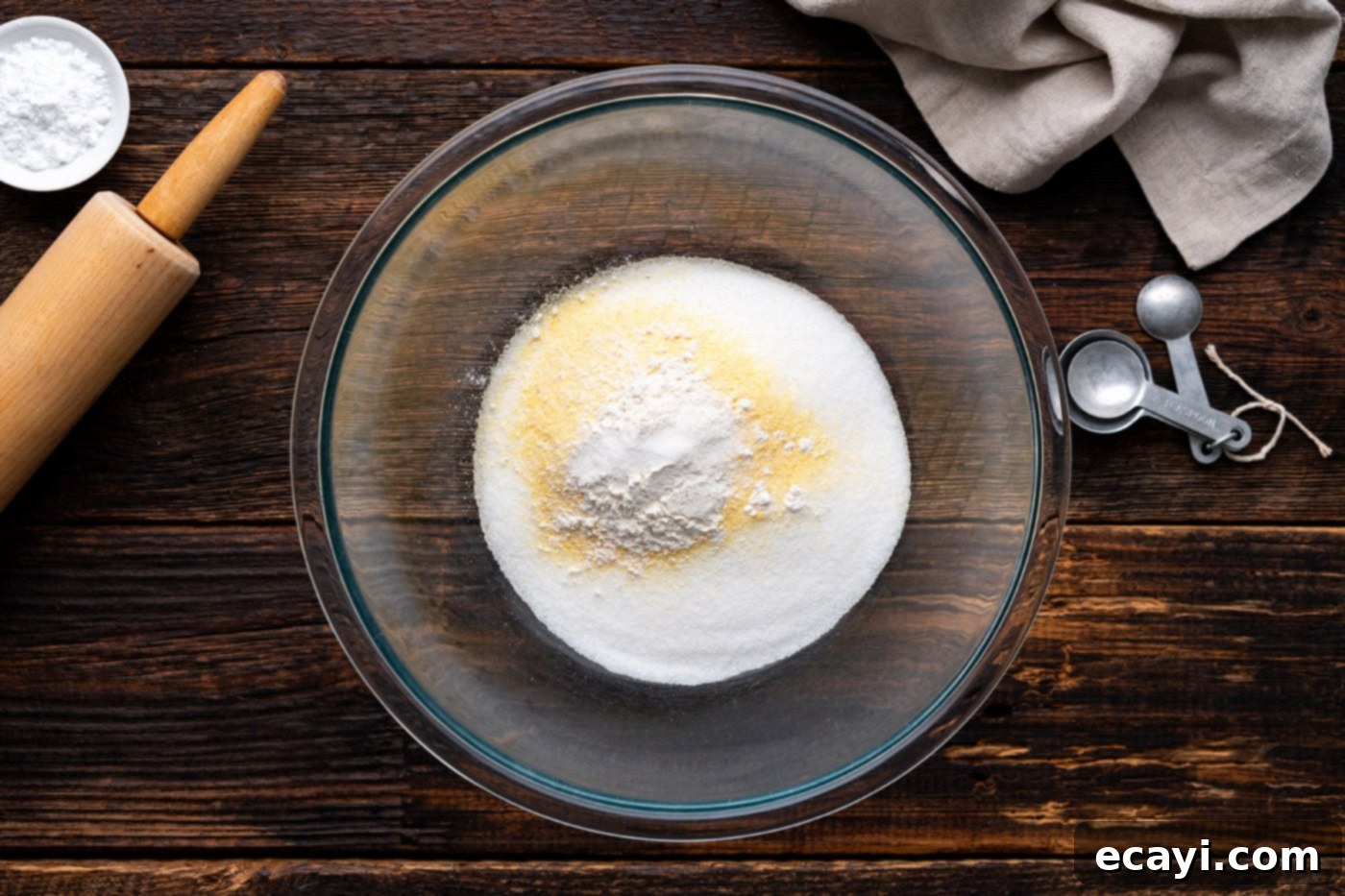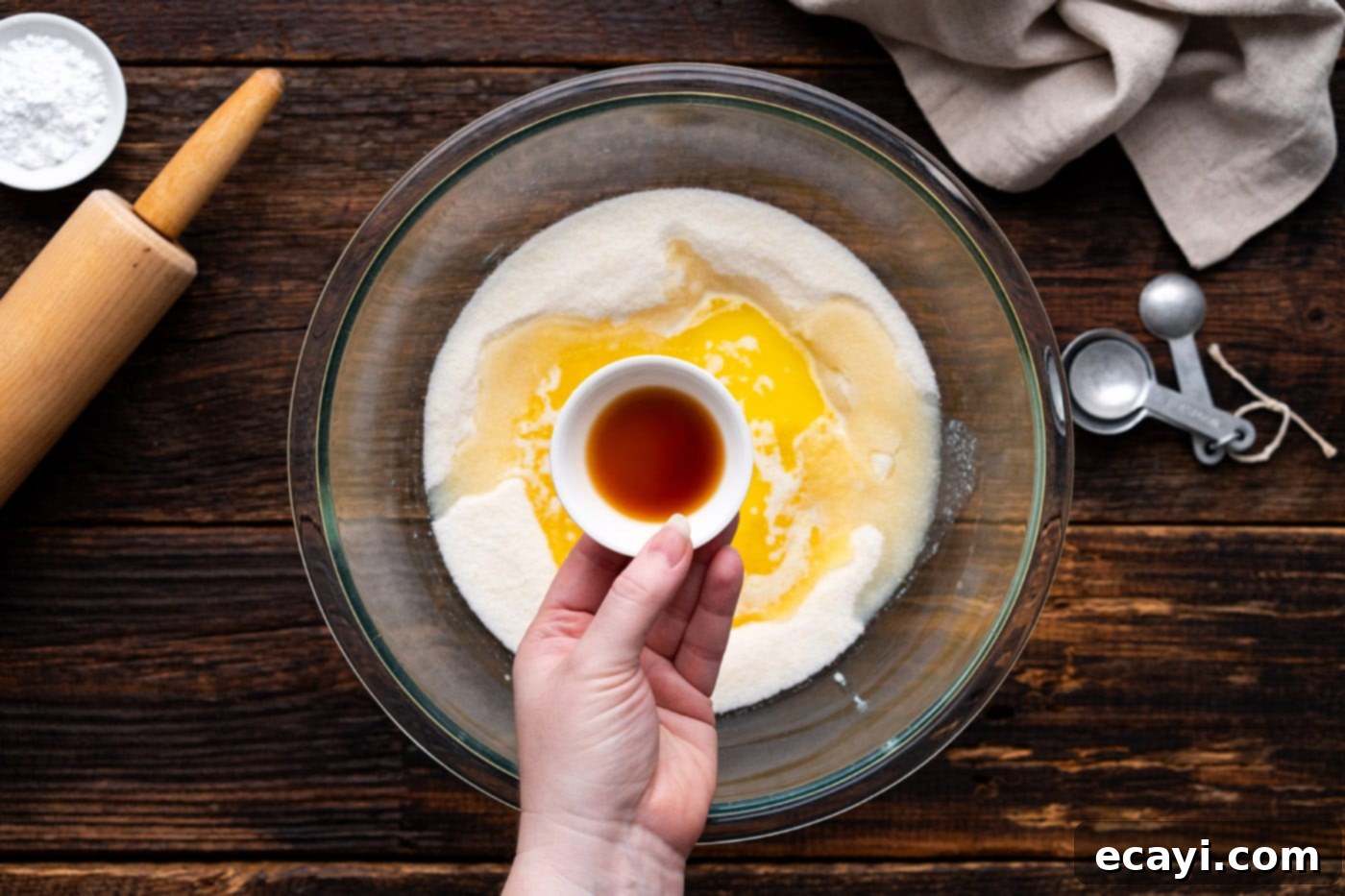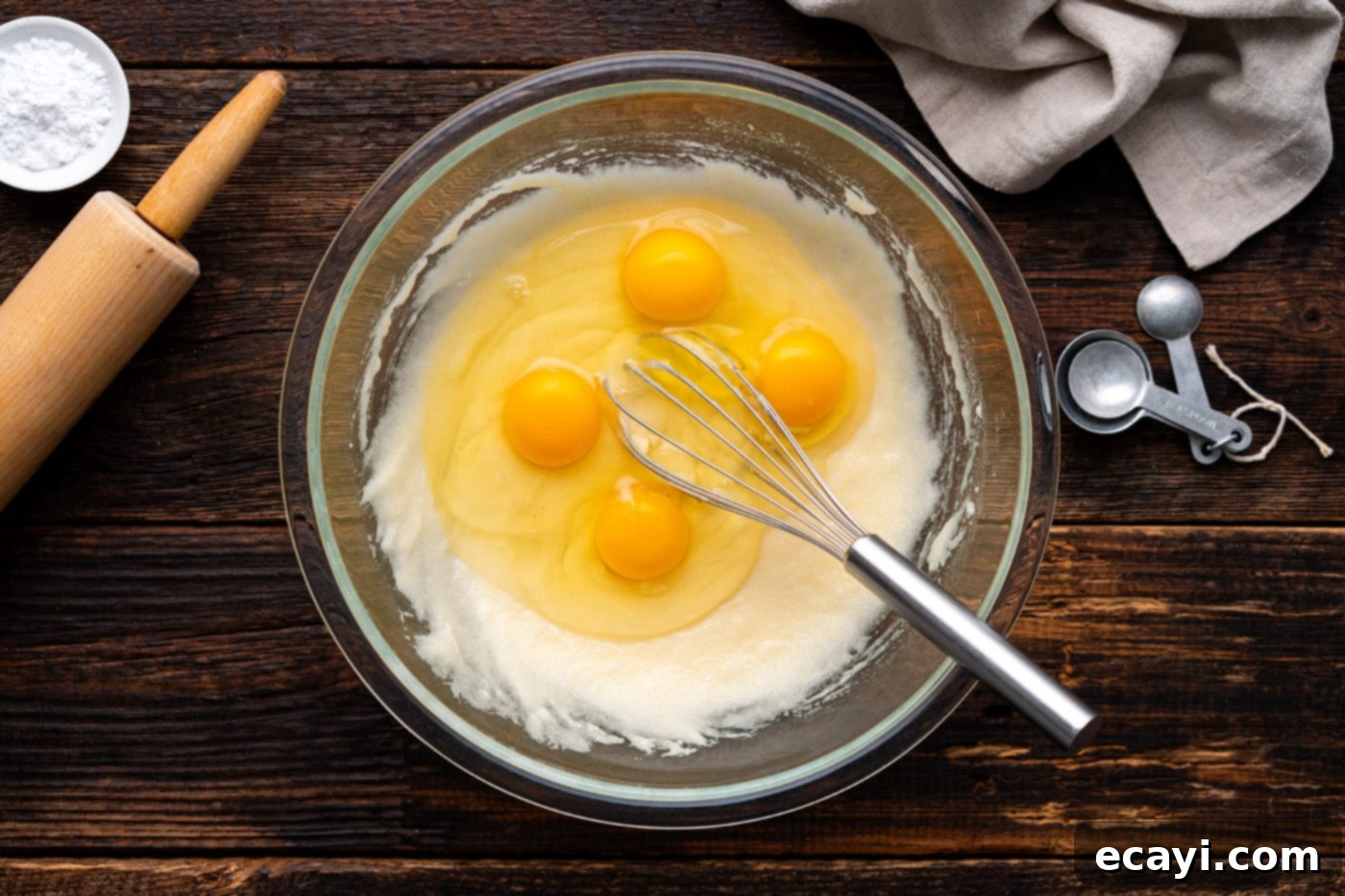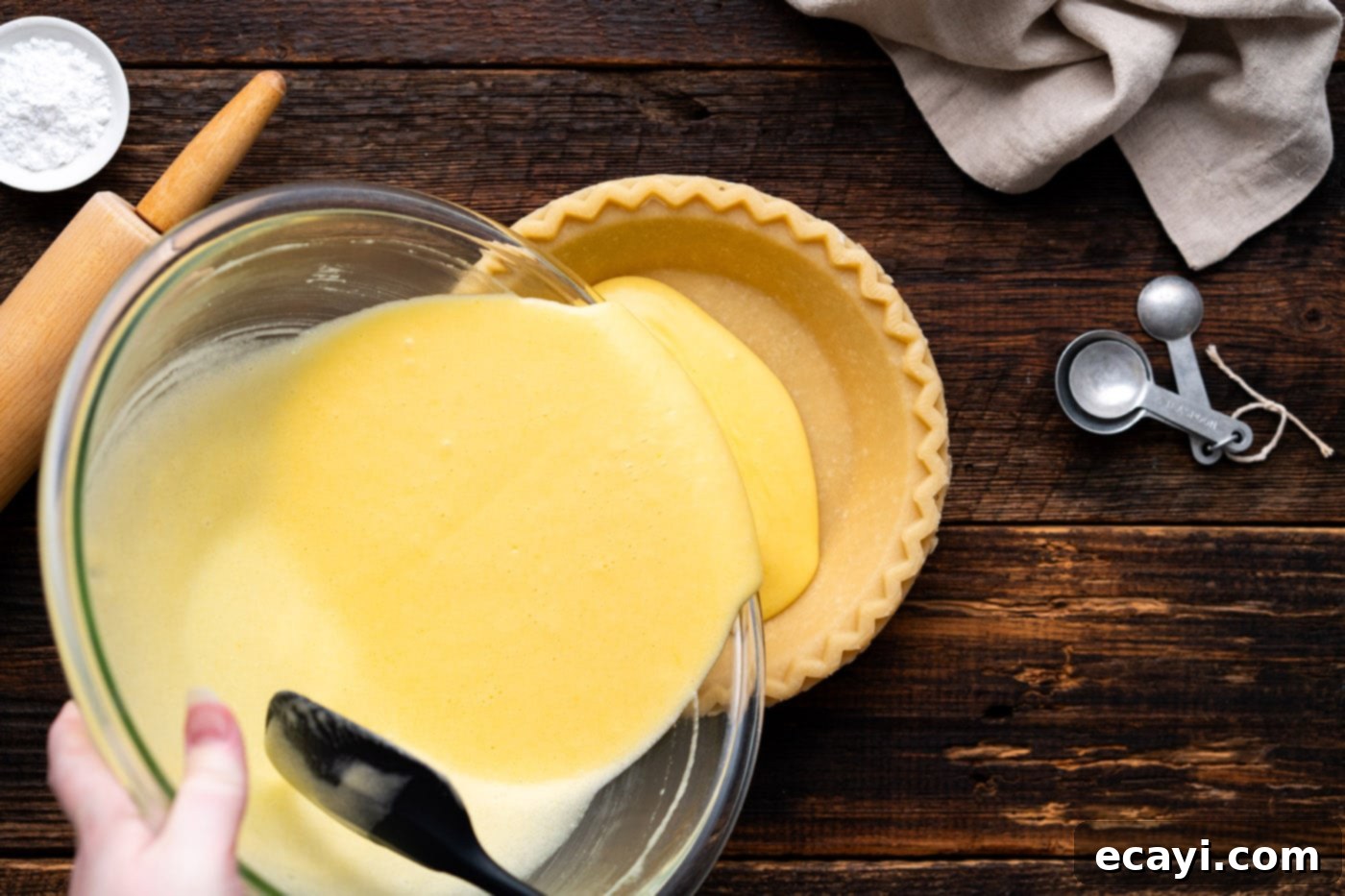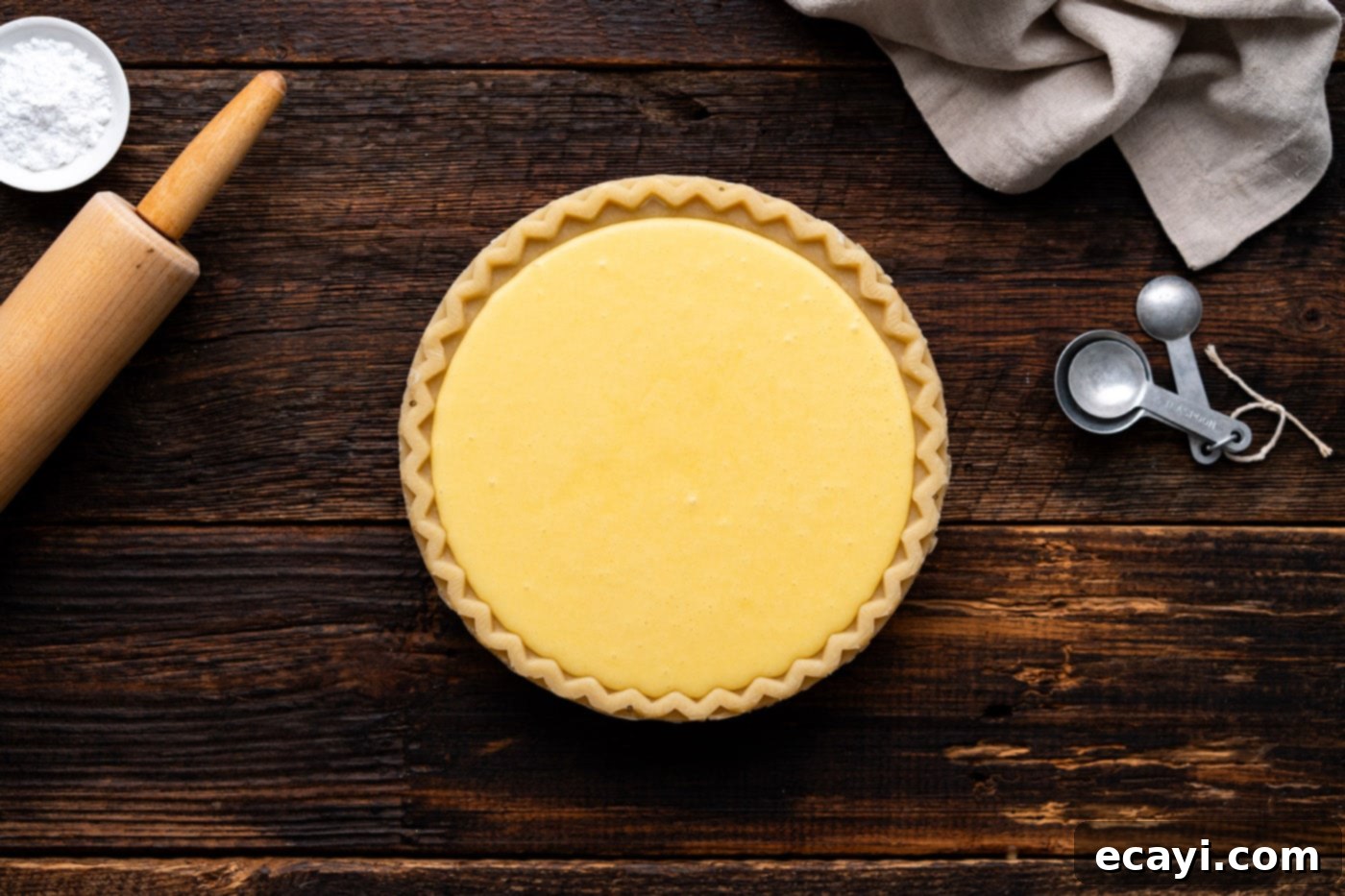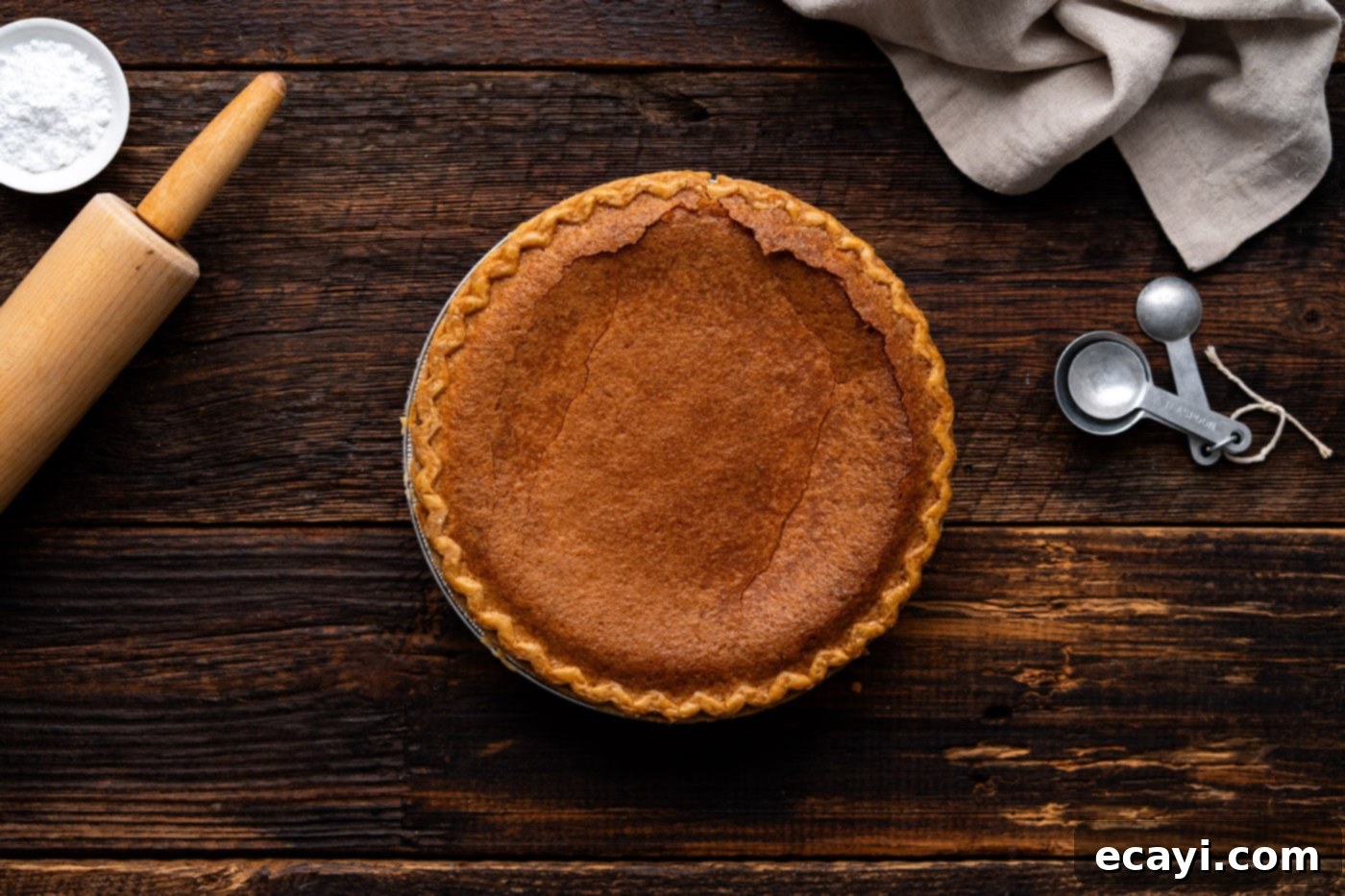Classic Southern Chess Pie: A Decadent, Easy-to-Make Custard Dessert
There’s nothing quite like a slice of homemade Chess Pie to transport you straight to the heart of Southern comfort. This beloved dessert is a true gem, renowned for its incredibly rich, creamy custard filling nestled within a perfectly flaky crust. What makes it truly special is how it achieves such a luxurious texture and deep flavor using remarkably simple pantry staple ingredients. If you’ve been searching for an easy, yet impressive, dessert that evokes warmth and nostalgia, this Chess Pie recipe is your answer. While the preparation is surprisingly quick, the most challenging part might just be summoning the patience required to let it cool to perfection before enjoying that first heavenly bite!
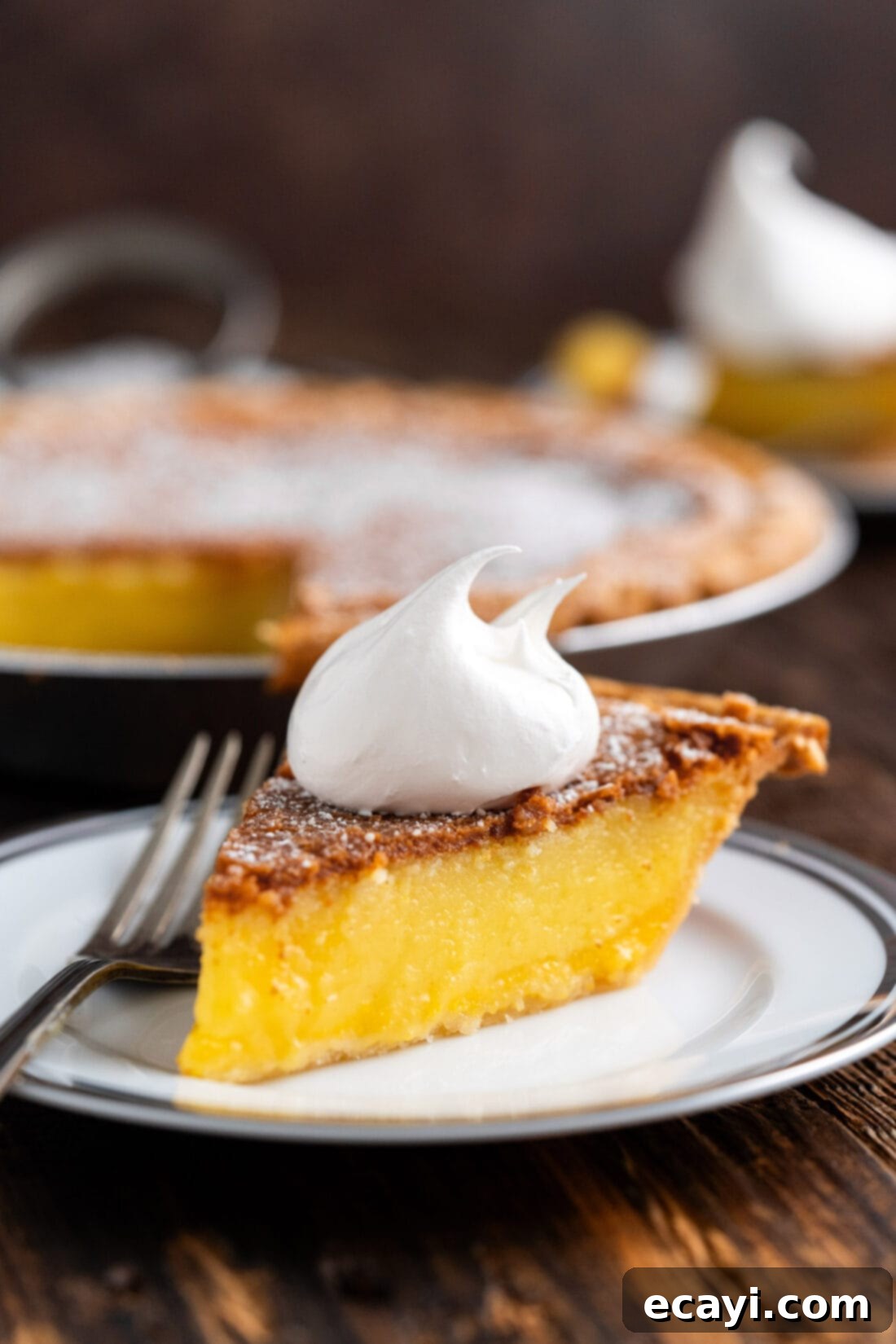
The Irresistible Charm of Chess Pie: A Deeper Dive
Often compared to a pecan pie in its satisfying density, Chess Pie carves out its own distinct identity. While many custard pies boast a smooth, silky texture, Chess Pie distinguishes itself with a unique addition: cornmeal. This seemingly humble ingredient isn’t just a thickener; it’s the secret behind the pie’s characteristic firm yet melt-in-your-mouth consistency, offering a subtle grit that adds to its charm without being coarse. The filling itself strikes a perfect balance of sweetness, expertly tempered by a touch of vinegar. This acidity not only brightens the flavor profile, preventing it from being cloyingly sweet, but also contributes to the custard’s smooth, non-crystalline finish.
As this delightful custard bakes, something truly magical happens: it gently soaks into the bottom pie crust, creating an exquisite, chewy layer right where the flaky crust meets the soft, sweet interior. This textural interplay is a hallmark of a well-made Chess Pie, making each forkful a journey through contrasting yet complementary sensations. It’s a dessert so profoundly comforting and delicious that it has earned its place as a staple on holiday dessert tables across the South. Many would agree that a celebration simply isn’t complete without this beautiful, golden-brown pie making an appearance.
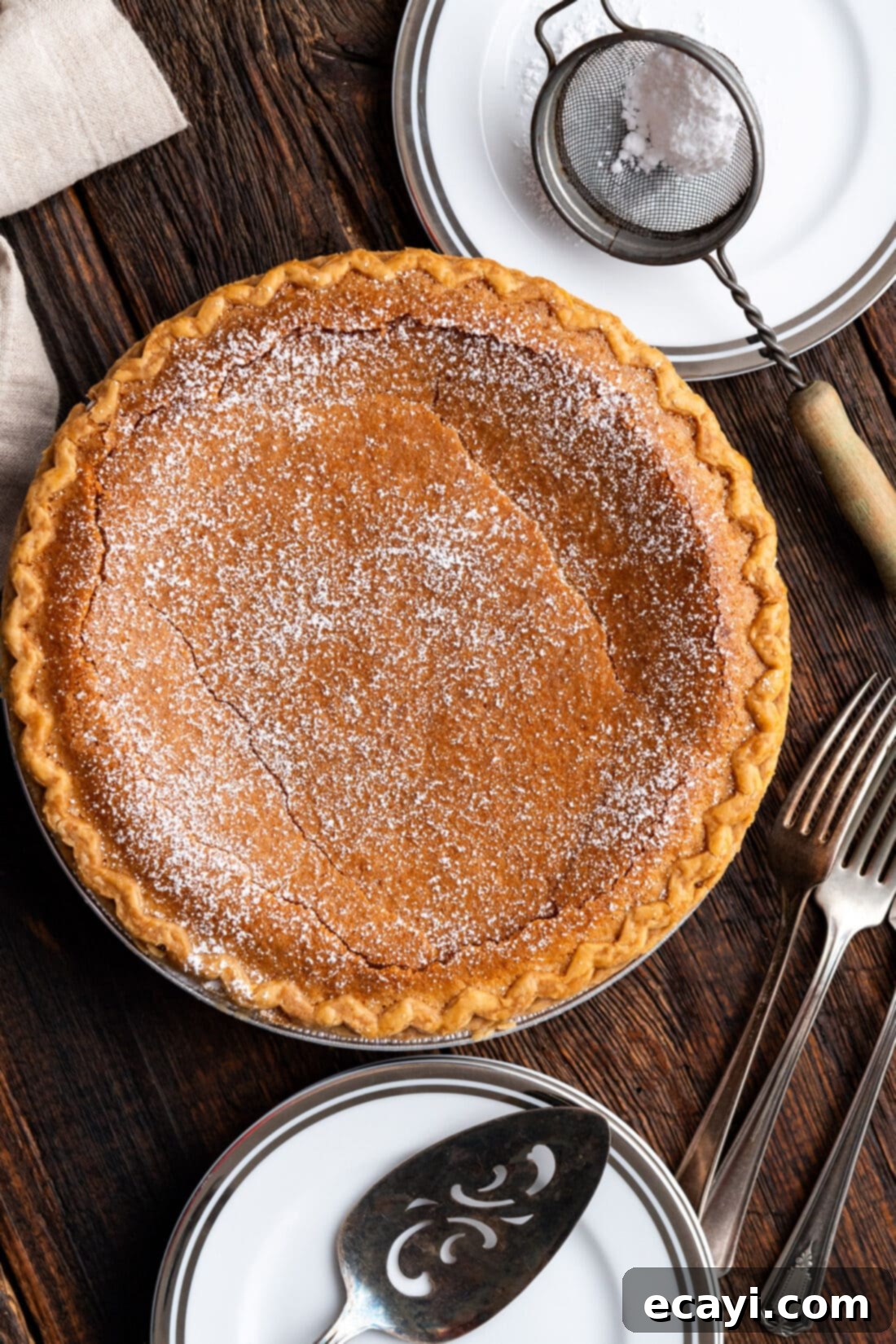
Essential Ingredients for Your Perfect Chess Pie
Crafting this classic Southern Chess Pie requires just a handful of straightforward ingredients, most of which you likely already have in your pantry. For precise measurements and a comprehensive list of all the components, please refer to the printable recipe card available at the conclusion of this post. But first, let’s explore the key players that bring this delightful dessert to life.
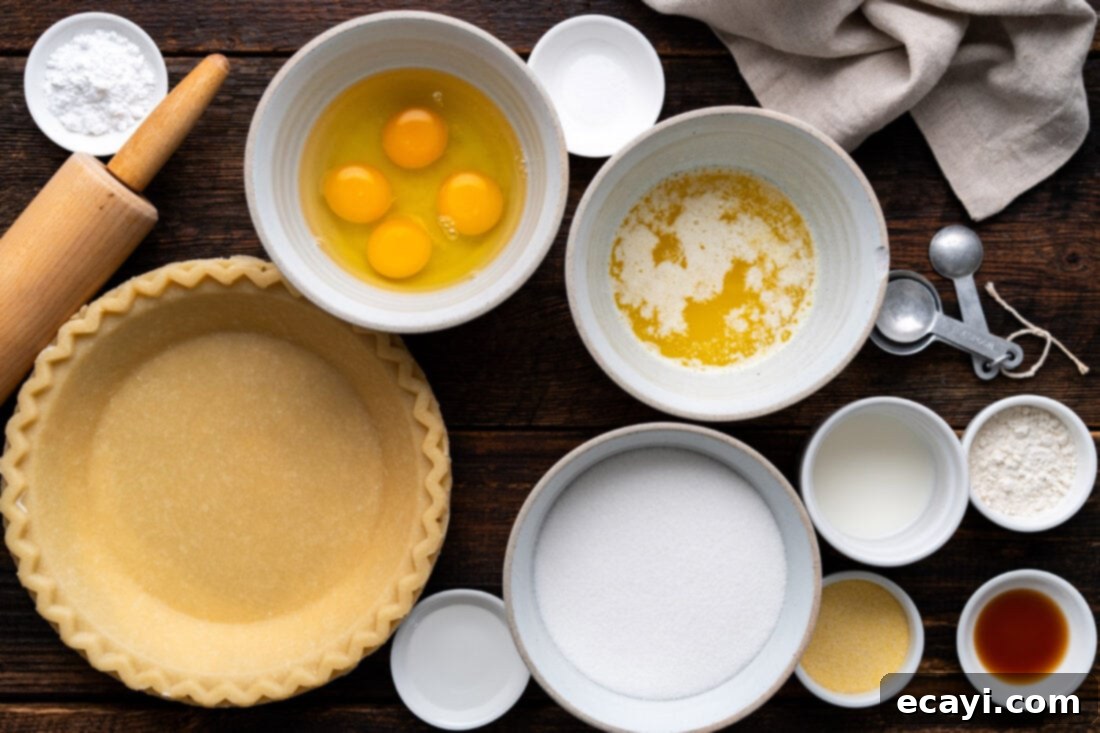
Ingredient Spotlight & Expert Substitution Tips
Let’s dive deeper into the ingredients that give Chess Pie its signature flavor and texture, along with helpful tips and potential substitutions to ensure your baking success.
For the Irresistible Custard Filling:
- Granulated Sugar: This is the primary sweetener, contributing to the pie’s characteristic sugary top crust and rich flavor. While integral, the vinegar helps to cut through its sweetness for a balanced taste.
- Yellow Cornmeal: This is the star ingredient that truly defines Chess Pie. Unlike many other custard pies, the cornmeal provides that distinct, slightly coarse yet firm texture. It helps thicken the custard, ensuring it sets beautifully without being overly dense. We strongly advise not omitting the cornmeal, as it’s fundamental to the pie’s authenticity and structure.
- All-Purpose Flour: A small amount of flour works in conjunction with the cornmeal to further thicken the custard, contributing to a smooth and cohesive filling.
- Salt: A pinch of salt is crucial for enhancing all the other flavors, preventing the pie from tasting flat and overly sweet. It balances the richness of the butter and sugar beautifully.
- Unsalted Butter (Melted and Cooled Slightly): Butter provides incredible richness and flavor, contributing to the pie’s luxurious mouthfeel. Ensure it’s melted but not hot, as hot butter can “cook” the eggs prematurely.
- Milk (at room temperature): The liquid base for our custard, milk adds creaminess and helps achieve the desired consistency. Using room temperature milk helps all ingredients combine smoothly and prevents the mixture from chilling the melted butter too quickly. Any type of milk (whole, 2%, skim) will work, but whole milk will yield the richest result.
- Distilled White Vinegar: This might seem like an unusual ingredient for a dessert, but it’s essential for two reasons. Firstly, it provides a crucial tangy counterpoint to the pie’s sweetness, creating a more complex and enjoyable flavor. Secondly, it’s often credited with preventing the sugar from crystallizing, ensuring a silky-smooth custard. If you don’t have distilled white vinegar, you can substitute it with 1 1/2 tablespoons of fresh lemon juice, which offers a similar acidic balance.
- Vanilla Extract: A classic flavor enhancer in sweet baked goods, vanilla extract adds warmth and depth to the custard, complementing its rich profile. Use good quality pure vanilla extract for the best results.
- Large Eggs (at room temperature): Eggs are the primary binding and thickening agent in any custard, giving Chess Pie its structure and richness. Ensuring they are at room temperature helps them incorporate more easily and evenly into the mixture, leading to a smoother custard.
Choosing Your Pie Crust:
When it comes to the crust, you have several convenient options that can significantly streamline your baking process:
- Frozen Pie Crust: For ultimate convenience, we often opt for a pre-made frozen crust. This is a fantastic time-saver and delivers consistent results. Just remember to thaw it thoroughly in the refrigerator before use.
- Store-Bought Refrigerated Pie Crust: Another excellent semi-homemade option is a store-bought refrigerated pie crust. These typically come rolled up and require you to unroll them and gently place them into a standard 9-inch pie plate. They bake up beautifully and save you the effort of making dough from scratch.
- Homemade Pie Crust: For those who enjoy the process or prefer a specific flavor and texture, making your own homemade pie crust is always an option. A buttery, flaky homemade crust can elevate the pie even further. Be aware that if you choose to make your own, or use a different type of store-bought crust, your bake time might vary slightly.
A note on bake time: The material of your pie plate can also influence baking time. Glass plates often retain heat longer and allow you to see the crust browning, while metal plates might cook faster. Keep an eye on your pie, especially towards the end of the baking cycle, and adjust as needed.
Baking Your Own Classic Chess Pie: A Step-by-Step Guide
These step-by-step photos and detailed instructions are here to guide you visually through the entire process of making this delicious Chess Pie. For a quick reference, including all precise measurements and a printable version of this recipe, you can Jump to Recipe at the bottom of this page.
- Prepare Your Oven: Begin by preheating your oven to 350°F (175°C). This ensures your oven is at the correct temperature when the pie goes in, promoting even baking.
- Combine Dry Ingredients: In a large mixing bowl, combine the granulated sugar, yellow cornmeal, all-purpose flour, and salt. Whisk these dry ingredients thoroughly until they are well combined. This step ensures that the cornmeal and flour are evenly distributed, preventing lumps in your final custard.

- Incorporate Wet Ingredients: To the dry mixture, add the slightly cooled melted butter, room temperature milk, distilled white vinegar, and vanilla extract. Whisk these ingredients together until they are fully incorporated and the mixture is smooth.

- Add the Eggs: Finally, whisk in the large eggs one at a time, ensuring each egg is fully combined before adding the next. Whisk until the mixture is uniform and smooth. Be careful not to over-whisk once the eggs are in, as this can incorporate too much air, leading to a less dense custard.

- Pour into Crust: Carefully pour the prepared Chess Pie filling into your chosen 9-inch pie crust. Distribute it evenly within the crust.

- Bake to Perfection: Transfer the pie to your preheated oven. Bake for approximately 60 to 75 minutes. The pie is done when the edges are set and golden brown, but the very center still has a slight, gentle wobble when lightly shaken. This slight jiggle indicates a perfectly set, creamy custard. Begin checking for doneness around the 45-minute mark and continue checking every 10 to 15 minutes thereafter. If you notice the pie crust starting to brown too quickly before the filling is fully set (this often happens around the 45-minute mark), loosely cover the edges of the crust with aluminum foil to prevent burning.


- Cool Completely: This step is critical! Allow the pie to cool undisturbed at room temperature for at least 2 hours, or until it has completely set. Resist the urge to slice into it too soon, as premature slicing can result in a runny or messy filling. The cooling process allows the custard to firm up and reach its ideal, creamy consistency.
- Garnish and Serve: Once cooled, you can dust the top of the pie generously with powdered sugar for a beautiful presentation. Slice and serve!
Frequently Asked Questions & Expert Tips for Chess Pie Success
The perfect Chess Pie will have set edges and a slight, gentle jiggle in the very center when you carefully nudge the pie plate. It should not be overly jiggly or liquidy. For a more precise test, you can insert a toothpick or a thin butter knife about an inch away from the crust; if it comes out clean, your pie is likely done. If the center is still too wobbly but your crust is browning rapidly, gently cover the pie’s edges with aluminum foil to prevent burning, and continue baking until the center is mostly set.
Once your Chess Pie has completely cooled to room temperature, store it in an airtight container or tightly wrap it with plastic wrap. It will keep beautifully in the refrigerator for up to 5 days. For the best flavor and texture, allow it to come to room temperature for about 30 minutes before serving, or enjoy it chilled.
Absolutely! Chess Pie freezes exceptionally well. After the pie is fully baked and has cooled completely to room temperature, wrap it tightly in a couple of layers of plastic wrap, followed by a layer of heavy-duty aluminum foil. For extra protection, you can place the wrapped pie in a large freezer-safe zip-top bag. It can be stored in the freezer for up to 2 months. To thaw, simply transfer it to the refrigerator overnight. You can also freeze individual slices using the same wrapping method, making it easy to enjoy a single serving whenever a craving strikes.
The origins of the name “Chess Pie” are a bit of a culinary mystery, but several theories exist. Some believe it’s a corruption of “cheese pie,” not because it contains cheese, but perhaps because early versions might have, or simply due to a mispronunciation of “chest pie” (a pie kept in a pie chest). Another popular theory suggests that its rich, sweet nature made it a favorite for entertaining, hence “jest pie” or “just pie” – implying it’s “just pie” and doesn’t need a fancy name, or that it’s good enough for company. Regardless of its true etymology, its deliciousness is undisputed!
Cracks in the surface of your Chess Pie are usually caused by overbaking or cooling too quickly. When a custard pie bakes for too long, the proteins in the eggs over-coagulate, causing the filling to contract as it cools. If the pie cools rapidly, the outer edges cool and set faster than the center, leading to tension and cracks. To minimize cracking, bake until just set (with that slight jiggle in the center) and allow it to cool slowly and completely at room temperature before refrigerating.
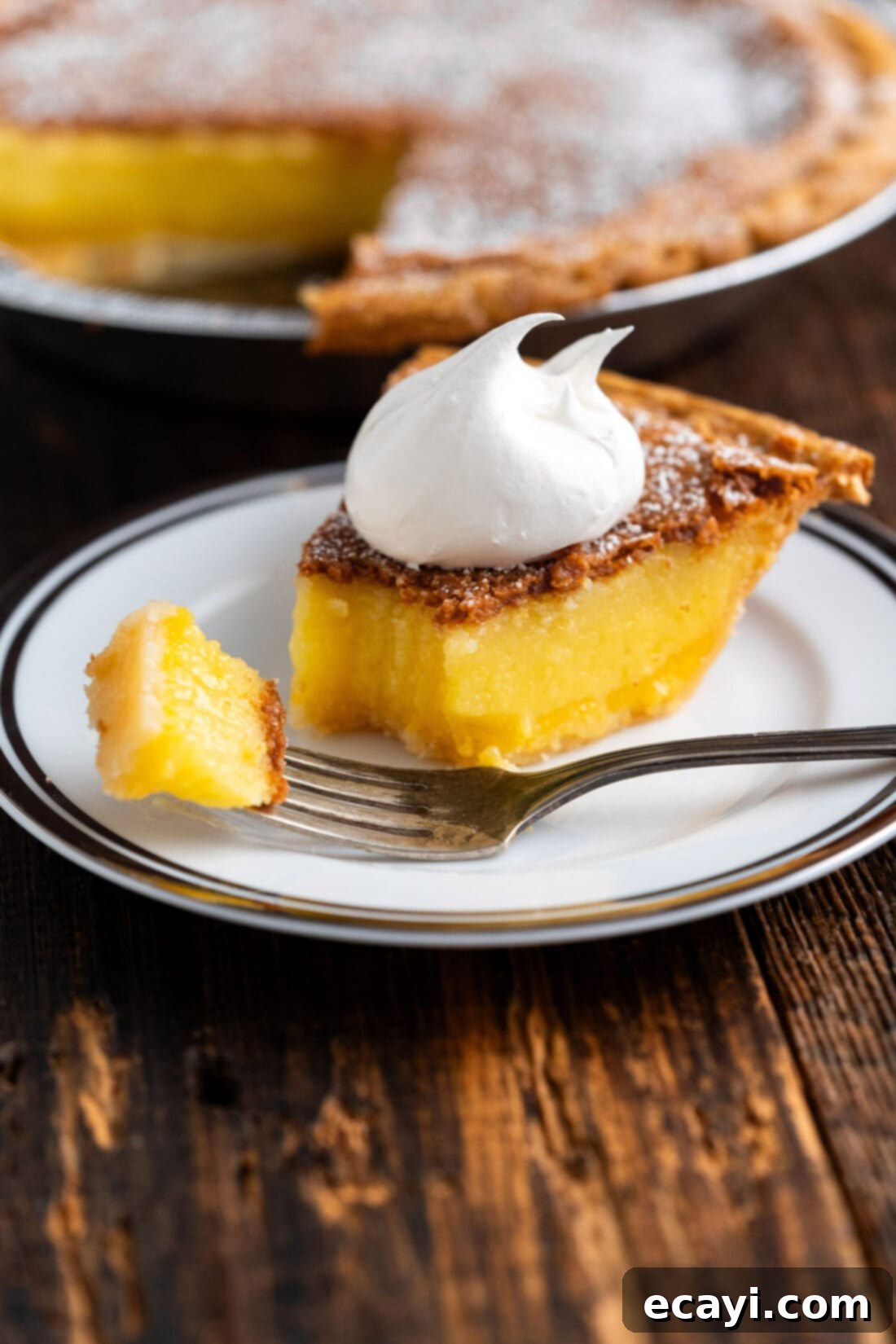
Delightful Serving Suggestions for Your Chess Pie
While Chess Pie is utterly delicious on its own, a few simple garnishes can elevate your serving experience. For a classic presentation, a light dusting of powdered sugar over the top adds an elegant touch and a subtle extra sweetness. For those who enjoy a little something extra, a generous dollop of freshly whipped cream or a scoop of premium vanilla ice cream makes a fantastic accompaniment, providing a cool, creamy contrast to the rich pie. You can enjoy Chess Pie either chilled from the refrigerator or at a comfortable room temperature. Remember, the most important serving tip is to ensure your pie has cooled completely to room temperature before attempting to slice it. This crucial cooling period allows the custard to fully set, guaranteeing perfect slices and the ideal, smooth texture.
Explore More Delicious Pie Recipes
If you’ve fallen in love with the art of pie making, or simply enjoy a comforting slice of dessert, be sure to explore some of our other fantastic pie recipes:
- Zesty Key Lime Pie
- Soul-Satisfying Sweet Potato Pie
- Creamy Banana Cream Pie
- Authentic Southern Buttermilk Pie
I absolutely adore sharing my passion for baking and cooking with all of you! To make sure you never miss out on a new recipe, I offer a convenient newsletter. Simply subscribe here and start receiving delicious, free daily recipes delivered straight to your inbox!

Classic Southern Chess Pie
IMPORTANT – There are often Frequently Asked Questions within the blog post that you may find helpful. Simply scroll back up to read them!
Print It
Pin It
Rate It
Save ItSaved!
Ingredients
- 1 ¾ cups granulated sugar
- 3 Tablespoons yellow cornmeal
- 2 Tablespoons all purpose flour
- ¼ teaspoon salt
- ½ cup unsalted butter melted and cooled slightly
- ¼ cup milk at room temperature
- 1 Tablespoon distilled white vinegar
- 1 teaspoon vanilla extract
- 4 large eggs at room temperature
- 1 9-inch frozen pie crust thawed in fridge, or homemade pie crust
- powdered sugar optional, for garnish
Things You’ll Need
-
Large mixing bowl
-
Whisk
-
Measuring cups and spoons
-
9-inch pie plate (if not using a pre-packaged crust that comes with one)
Before You Begin: Important Notes for Success
- The cornerstone of Chess Pie’s unique texture is cornmeal. It’s truly a non-negotiable ingredient, as it provides the specific firmness and slight grit that sets this custard pie apart.
- The vinegar in the recipe serves a dual purpose: it balances the pie’s sweetness with a pleasant tang and helps prevent the sugar from crystallizing for a smoother filling. If you don’t have distilled white vinegar, 1 1/2 tablespoons of fresh lemon juice is an excellent substitute.
- Regarding the crust, you have flexibility! We used a frozen pie crust for convenience, but a store-bought refrigerated crust or a homemade pie crust works beautifully. Just be aware that bake times can vary depending on the type of crust and the material of your pie plate.
- If using a store-bought frozen pie crust, remember to thaw it completely in the refrigerator beforehand. It should be chilled but pliable, not frozen solid, for the best results when filling.
Instructions
-
Preheat your oven to 350°F (175°C).
-
In a large bowl, whisk together the granulated sugar, cornmeal, flour, and salt until well combined. Add the melted butter (cooled slightly), milk, vinegar, and vanilla extract; whisk until smooth. Finally, whisk in the eggs until fully incorporated.
-
Pour the prepared mixture evenly into your 9-inch pie crust.
-
Bake for 60 to 75 minutes, or until the pie’s edges are golden and set, but the center retains a slight, gentle wiggle. Begin checking around the 45-minute mark. If the crust starts to brown too much before the center sets, loosely cover the edges with aluminum foil.
-
Allow the pie to cool completely to room temperature (approximately 2 hours) before slicing and serving. This is crucial for the custard to properly set.
-
For serving, an optional dusting of powdered sugar adds a lovely finish.
Expert Tips & FAQs
- Testing for Doneness: Your Chess Pie is perfectly baked when the edges are firm and slightly golden, but the very center still has a slight, delicate jiggle when you gently shake the pie dish. Avoid overbaking, as this can lead to a cracked surface. A toothpick or thin knife inserted about an inch from the crust should come out clean.
- Proper Storage: Once fully cooled, store the Chess Pie in an airtight container or wrapped tightly with plastic wrap. It will keep well in the refrigerator for up to 5 days, though it’s often best enjoyed within the first 2-3 days.
- Freezing Instructions: To freeze, ensure the baked and cooled pie is wrapped thoroughly in multiple layers of plastic wrap, followed by a layer of aluminum foil. You can also place it in a large freezer-safe bag. It can be frozen for up to 2 months. Thaw completely in the refrigerator overnight before serving. Individual slices can also be frozen using the same method for convenient single servings.
- Preventing a Burnt Crust: If your pie crust begins to brown too quickly during baking, especially the crimped edges, gently cover the edges with aluminum foil. This acts as a shield, allowing the filling to finish baking without the crust getting too dark.
Nutrition
The recipes on this blog are tested with a conventional gas oven and gas stovetop. It’s important to note that some ovens, especially as they age, can cook and bake inconsistently. Using an inexpensive oven thermometer can assure you that your oven is truly heating to the proper temperature. If you use a toaster oven or countertop oven, please keep in mind that they may not distribute heat the same as a conventional full sized oven and you may need to adjust your cooking/baking times. In the case of recipes made with a pressure cooker, air fryer, slow cooker, or other appliance, a link to the appliances we use is listed within each respective recipe. For baking recipes where measurements are given by weight, please note that results may not be the same if cups are used instead, and we can’t guarantee success with that method.
